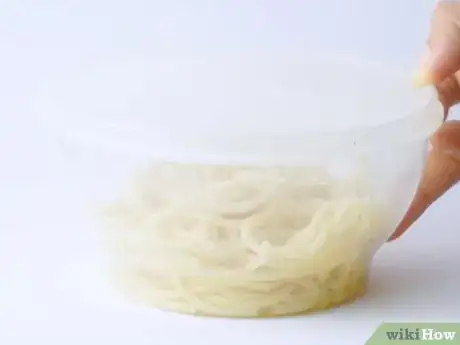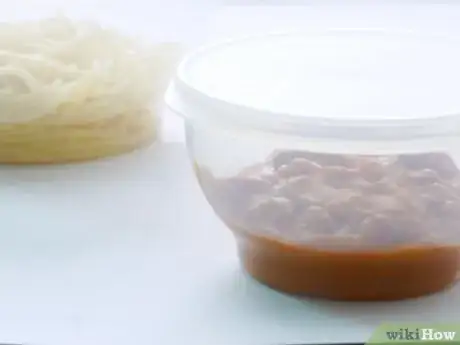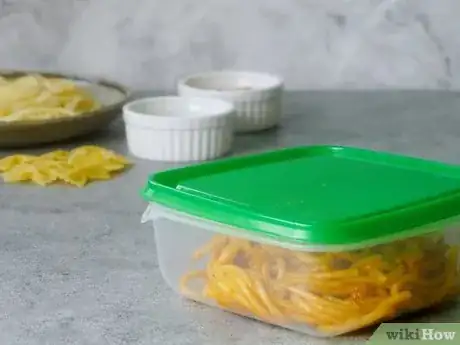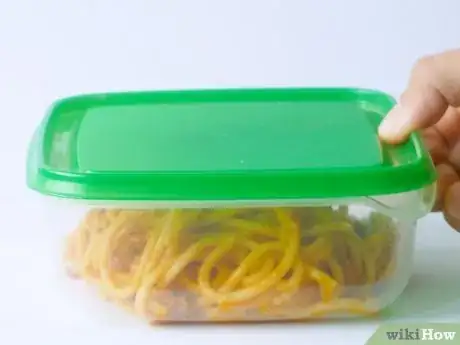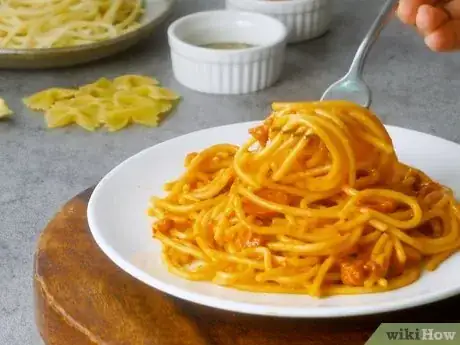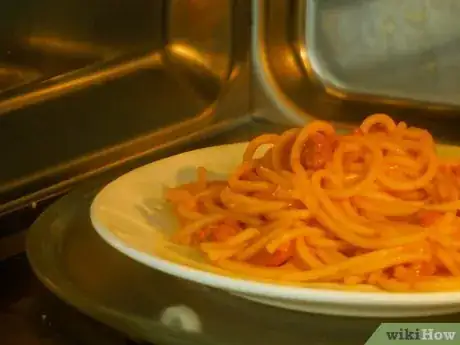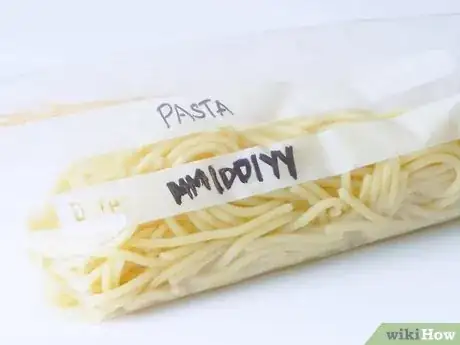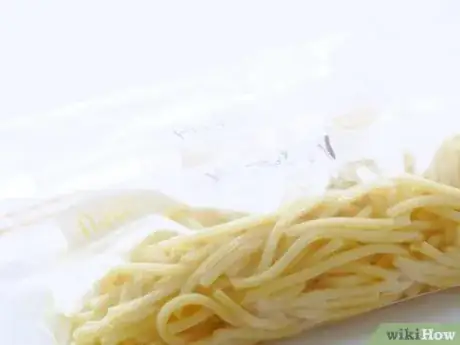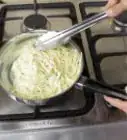This article was co-authored by wikiHow Staff. Our trained team of editors and researchers validate articles for accuracy and comprehensiveness. wikiHow's Content Management Team carefully monitors the work from our editorial staff to ensure that each article is backed by trusted research and meets our high quality standards.
There are 8 references cited in this article, which can be found at the bottom of the page.
The wikiHow Culinary Team also followed the article's instructions and verified that they work.
This article has been viewed 58,499 times.
Learn more...
After serving up a scrumptious Italian dinner, you might be stumped over what to do with the leftovers. Due to their perishable ingredients, it's important for plain cooked pasta and pasta dishes to be properly preserved. Otherwise, they can quickly lose freshness and moisture and even begin to grow mold. In order to prevent this, be sure to refrigerate uneaten pasta within two hours of serving it, and freeze leftovers that you aren't planning on eating right away. When stored correctly, leftover pasta can be reheated and enjoyed days or even months after it's first prepared.
Steps
Refrigerating Pasta on its Own
-
1Place the cooked pasta in an airtight container. The container you use should have a lid or other type of secure closure to keep air from getting in. When exposed to air, the moisture in cooked pasta can become a breeding ground for bacteria and mold. Make sure the container is fully sealed before putting the pasta away.[1]
- If you're storing your pasta in a Ziploc bag, squeeze as much air out of the bag as you can before sealing and stashing it.
- Make sure to refrigerate leftover pasta within two hours of preparing it to keep it from going bad prematurely.[2]
-
2Add some butter or olive oil to the pasta. A little oil or butter will keep the cooked pasta from clumping and sticking as it dries out. Stir the oil or butter into the pasta until its coated lightly and evenly. This will make it much easier to reheat later on.[3]
- 1-2 teaspoons should do for an average serving size. The pasta only needs to be lightly coated.
- Toss freshly-made pasta with flour immediately prior to refrigerating.[4]
Advertisement -
3Refrigerate the pasta. Cooked, un-sauced pasta will usually stay fresh in the refrigerator for 3-5 days. After that, the pasta will begin to lose its flavor and can even mold if left for too long. Store the pasta away from other foods that may transfer unwanted odors.[5]
- Find a place for your leftovers on the top or middle shelf where they'll be in plain sight. Otherwise, you may forget about them.
- You can reheat refrigerated pasta by dunking it in a pot of boiling water for 20-30 seconds.
-
4Store pasta sauce separately. If you've made a sauce to serve with the pasta, it should go in a different container. Most pasta sauces will keep for about a week when properly sealed and refrigerated. However, tomato-based sauces tend to last longer than cream sauces due to their acidity.[6]
- If you're unsure whether the sauce is still good after 6-7 days, take a whiff and use your best judgment.
- Reheat leftover pasta sauce on the stovetop when serving it a second time.
- Cream sauces can be difficult to reheat on their own, as the fat and dairy components have a tendency to separate when refrigerated after cooking.[7]
Refrigerating Sauced Pasta
-
1Transfer leftovers to an airtight container. Pasta that has already been mixed together with sauce will still keep just fine. Pour the sauced pasta into a Tupperware container or large Ziploc bag and seal it up. Make sure there's as little air in the container as possible before closing it, as contamination will speed up the growth of mold.[8]
- Let hot pasta cool to just above room temperature before transferring it to a separate storage container.[9]
- Storing the pasta and sauce together can greatly simplify your storage situation if you don't have a lot of space to work with.
-
2Stick the pasta in the refrigerator. Make room for the pasta on one of the upper shelves. The cool conditions will keep it fresh for a few days. Remember not to bury your leftovers behind other items, or your could forget about them until they go bad.
- It may help to label your leftover pasta with the item name and refrigeration date.
-
3Use within 2-3 days. In most causes, sauced pasta will keep for up to 3 days, but it will be better if consumed within a day or two. The longer the pasta sits, the more it will absorb the flavor of sauce. Eventually, this can make the pasta mushy and overpower its more subtle notes.[10]
- If you're not sure whether you'll be reheating the refrigerated pasta within this time frame, you may be better off freezing it instead.
- Pasta can actually be even better leftover, after the individual flavors have had more of a chance to mingle.[11]
-
4Warm up sauced pasta in the oven. A microwave can heat leftover pasta unevenly and deaden its flavor. For better results, scrape the refrigerated pasta into a baking dish and place it in the oven for about 20 minutes at 350 degrees F (176 degrees C). Make sure the pasta is heated throughout, then remove it from the oven and let it cool before enjoying.[12]
- Covering the baking dish with aluminum foil will help lock in moisture as the pasta cooks so that it doesn't come out too dry.
- You could also reheat sauced pasta on the cooktop over low heat, stirring frequently.
Freezing Leftover Pasta
-
1Place the uneaten pasta in a large freezer bag. One advantage of pasta is that it freezes well, whether it's been combined with sauce or not. Make sure to press all excess air out of the bag before sealing it.[13]
- The thin material of plastic freezer bags makes them better for freezing than thicker containers.
- Drizzle the past with oil or butter before freezing it. The added fat will come in handy during the reheating process, serving to break up frozen clumps.
-
2Store the pasta in the freezer. Once it's frozen, the leftover pasta will be preserved for three months or longer. However, you should aim to eat the leftover pasta within one to two months for optimum freshness and flavor. [14]
- When left frozen for too long, high water content foods like cooked pasta can become freezer burned, which will ruin the flavor and make it difficult to reheat properly.[15]
- Mark frozen leftovers with the date so you'll remember to use them before they expire.
-
3Thaw the pasta in the refrigerator before reheating. Rather than attempting to thaw the frozen pasta at room temperature, transition it to the refrigerator. This will allow it to reach a mild temperature much more gradually, preserving the flavor and texture. The pasta can then be heated in boiling water and combined with sauce, while sauced pasta can be reheated in the oven.[16]
- The pasta will likely require a few hours in the refrigerator to thaw completely.
- Pasta that has been thawed in the refrigerator will usually be edible for another 3-4 days.[17]
Warnings
- Once thawed, leftover pasta should not be refrigerated or frozen a second time.⧼thumbs_response⧽
- Always throw out pasta or sauce if it has unpleasant odor or shows signs of mold or freezer burn. It may be unsafe to consume these foods if they've begun to breed bacteria.⧼thumbs_response⧽
Things You'll Need
- Airtight storage container
- Refrigerator or freezer
- Olive oil or butter
- Oven, cooktop or microwave (for reheating)
References
- ↑ http://www.bhg.com/recipes/how-to/food-storage-safety/storing-cooked-pasta/
- ↑ http://www.stilltasty.com/fooditems/index/17887
- ↑ http://www.recipetips.com/kitchen-tips/t--166/pasta-handling-safety-storage.asp
- ↑ http://www.thekitchn.com/how-to-make-fresh-pasta-from-scratch-cooking-lessons-from-the-kitchn-73435
- ↑ http://www.bhg.com/recipes/how-to/food-storage-safety/storing-cooked-pasta/
- ↑ http://www.recipetips.com/kitchen-tips/t--166/pasta-handling-safety-storage.asp
- ↑ https://www.thekitchn.com/whats-the-best-way-to-reheat-c-112736
- ↑ http://www.recipetips.com/kitchen-tips/t--166/pasta-handling-safety-storage.asp
- ↑ http://www.bhg.com/recipes/how-to/food-storage-safety/storing-cooked-pasta/
- ↑ http://www.recipetips.com/kitchen-tips/t--166/pasta-handling-safety-storage.asp
- ↑ https://www.forbes.com/sites/nadiaarumugam/2011/11/23/the-science-of-leftovers-why-they-taste-so-good/#77b44b9a7d27
- ↑ https://www.realsimple.com/food-recipes/cooking-tips-techniques/cooking/reheat-leftover-pasta
- ↑ http://www.bhg.com/recipes/how-to/food-storage-safety/storing-cooked-pasta/
- ↑ http://www.stilltasty.com/fooditems/index/17887
- ↑ https://www.loc.gov/rr/scitech/mysteries/freezerburn.html
- ↑ http://www.recipetips.com/kitchen-tips/t--166/pasta-handling-safety-storage.asp
- ↑ http://www.stilltasty.com/fooditems/index/17887
About This Article
To store leftover pasta properly, first place your cooked pasta into an airtight container. Make sure the container you use has a lid to keep air from getting in. Add some butter or olive oil to the pasta to keep it from clumping and sticking.The pasta only needs to be lightly coated, so 1-2 teaspoons should do for an average serving size. Next, refrigerate the pasta. Cooked, un-sauced pasta will usually stay fresh in the refrigerator for 3-5 days. If you’re storing your pasta sauce in a separate container, that can stay refrigerated for 6-7 days. Make sure to refrigerate leftover pasta within two hours of preparing it to keep it fresh. To store pasta that is already sauced, let the hot pasta cool to just above room temperature and then transfer the leftovers to an airtight container. Refrigerate the pasta and eat it within 2-3 days. For instructions on how to freeze leftover pasta for up to several months, read on.


